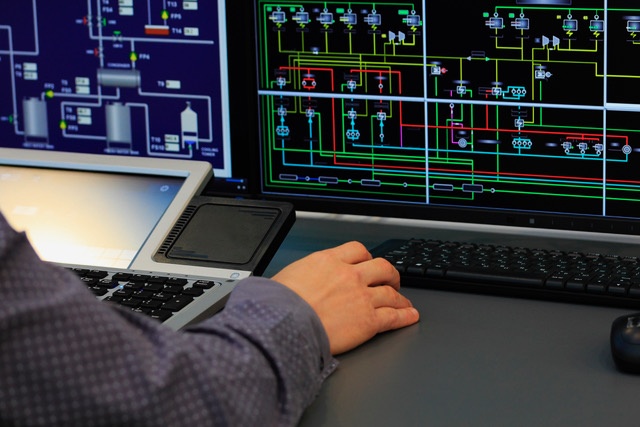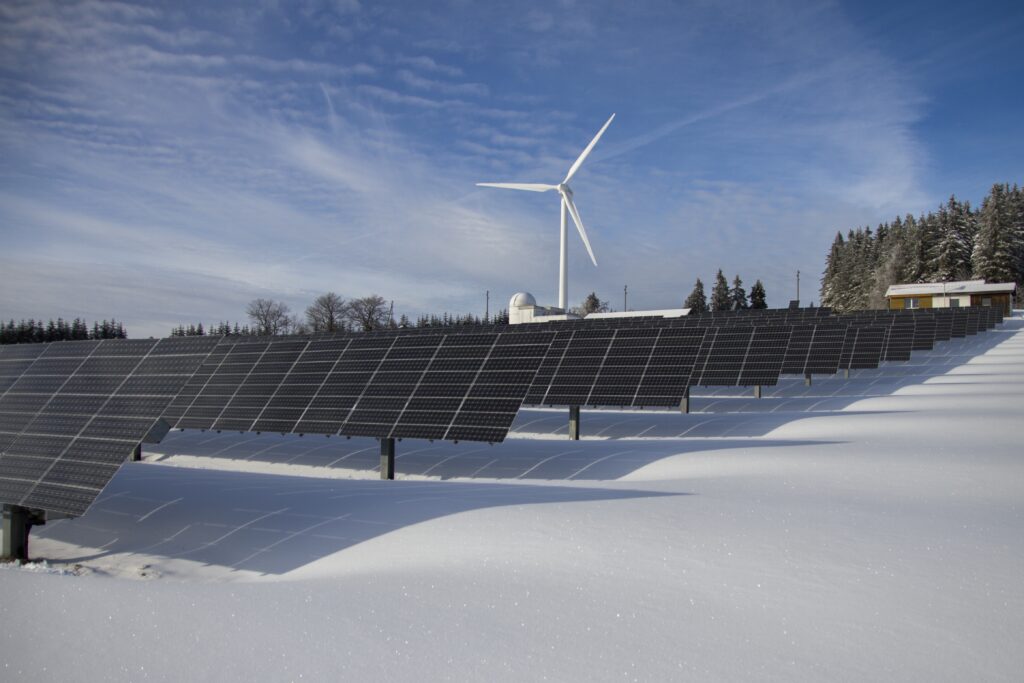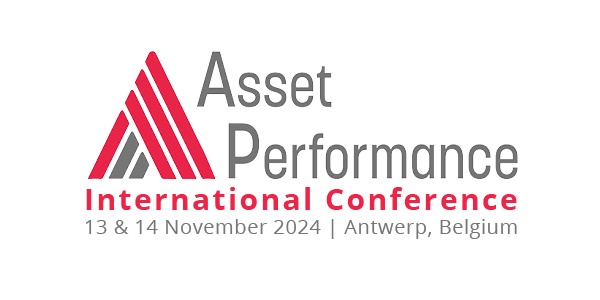Energy efficiency and cost control in companies
Round table debate
“High energy prices have led to a huge interest in all working together to reduce our energy consumption. I hope that drive will continue.”
Heat waves, droughts, floods, forest fires, rising sea levels, shrinking biodiversity: the effects of climate change are becoming increasingly visible and palpable of late. With the European Climate Law, the European Union aims for CO2 neutrality by 2050 in order to limit global warming to 1.5 degrees Celsius. Companies and enterprises can do a lot to reduce their CO2 emissions. Although increased energy prices make most companies realise the cost benefits of energy-saving measures, many lack a concrete strategy and a systematic approach to energy efficiency within the organisation. Consequently, many companies exploit only a fraction of the opportunities in this area.
BEMAS director Wim Vancauwenberghe brought three professionals together who work on energy efficiency at their companies. The experiences and insights of Wim Dedeurwaerder (Head of Infrastructure and Technical Installations at the Belgian Ministry of Defence), Peter Vos (Energy Manager at Agristo) and Steven Vandenbulcke (Plant Manager at A&S Energie and A&U Energie) can inspire and help other companies and organisations to improve their energy efficiency, thus contributing to achieving the EU’s sustainable objectives.





How is energy efficiency addressed in your job?
Dedeurwaerder: “I am responsible for the technical installations of the infrastructure and related energy management at the Belgian Ministry of Defence. The first pillar comprises all technical installations linked to buildings, from heating to high-voltage installations. The second pillar comprises the energy management of this patrimony, where we always focus on the sustainable use of energy. “
Vos: “Agristo makes frozen potato and sweet potato-based products: fries, mashed potatoes, gratin, croquettes… Due to the nature of our products – pre-fried and frozen – we are an energy-intensive company with a high need for both heating and cooling. As Energy Manager, I am responsible for improving energy efficiency at our four plants in Belgium and the Netherlands. On the one hand, this relates to the production process and also to the use of renewable energy and sustainability in general. It also includes water consumption.”
Vandenbulcke: A&S Energie and A&U Energie are two green energy plants in Oostrozebeke and Wielsbeke, built by energy specialist Aspiravi and Unilin, best known for Quick-Step. We generate electricity and heat from incinerating non-recyclable waste wood. As Plant Manager, I am responsible for the overall management of the plants, with the aim of keeping them running as efficiently as possible. We supply heat to companies such as Agristo, which they use to fry chips, and of course to Unilin. The electricity produced that is not absorbed by the companies is injected into the public electricity grid.”
What does the volatility of energy prices mean for you as an energy producer?
Vandenbulcke: “The fact that energy prices are rising does not mean that we as energy producers are making a killing, as people sometimes think because of what they hear in the media. After all, as energy producers, we sold our energy a long time ago. So when daily prices shoot up today, we don’t really notice it. Of course, we do experience that there is more interest in our green heat energy to save natural gas and reduce increased costs. This is a good thing for the climate and for our companies, but we certainly do not ‘profit’ from the situation, because we always try to build long-term relationships. In that sense, our customers are more partners than customers!”
“I see an important role for the government to keep companies and organisations motivated to invest in sustainability.”
Steven Vandenbulcke, Plant Manager at A&S Energy and A&U Energy
How do volatile energy prices affect Agristo?
Vos: “They put a lot of pressure on our organisation. When energy prices are volatile, it is difficult for us to make accurate estimates for the prices of our products. As Steven pointed out, the prices of many raw materials have also gone up. If everything becomes more expensive you have no choice but to pass this on to the customer, which is obviously not pleasant.”
How does Agristo try to hedge against this volatility in the market?
Vos: “We do that in different ways. On the one hand, we hedge by fixing a certain energy volume several years in advance. On the other hand, we try to use energy efficiently and sparingly throughout our organisation. Our employees have become very aware of this, especially over the past year. They make an effort to save energy because they realise from their personal situation how expensive it has become. In that respect, the energy crisis is positive: it has fuelled the will and drive to make changes.”

Are you experiencing the same at Defence, Wim?
Dedeurwaerder: “We are a major consumer of energy, so rising energy prices also bring challenges for us. As a government department, we work with a budget which is valid for one year at a time. That means we get funds at the beginning of the year and then have to make do with them for a whole year – a fundamental difference from the private sector. It often creates difficulties when transitioning to a new budget year. In principle, we can base ourselves on last year’s consumption, but it is not that simple. Because the budget we need is our consumption multiplied by the unit price. If that is volatile and rising, you can imagine it is a budgetary challenge.”
Peter mentioned that Agristo employees are more aware of the cost of energy. Is that the same for you?
Dedeurwaerder: “Definitely. But we have been working on energy efficiency for longer than today. For decades we have been active in operations abroad, Afghanistan for example. To do our work there, we need a lot of energy. That costs a huge amount of money – even human lives are at stake. So it is important that as an organisation we use energy consciously there. This is equally true in Belgium, for our barracks and our other buildings.”
Peter, what action is Agristo taking on the shop floor to save energy?
Vos: “At the beginning of 2022, I received emails from several employees asking how they could save energy quickly and cheaply at the company. But we had already implemented all those things, the easy work had already been done. In recent years we have also put a lot of effort into energy recovery, i.e. residual heat. Renewable energy, solar panels and biogas are also things we have been investing in for a long time. Therefore, our focus today is on making the production lines at our plants more energy-efficient. We encourage our employees to look more at the processes. Does it really have to be at that temperature or at that speed? Is it effectively necessary to run this machine for a particular product? By consciously thinking about this and making the necessary adjustments, we use 6% less electricity and 8% less gas on average in one year. This proves that there is a lot to be gained by scrutinising our processes.”
Do you use a digital tool to make those things visible, or are they insights that come purely from the people on the shop floor themselves?
Vos: “We have been working intensively on digitalisation for a few years now. My focus until now has mainly been on developing water dashboards to map our water consumption. Now energy dashboards are my priority. All energy meters are digitised and visualised as much as possible so that we can make this transparent for colleagues. It also shows them where they can save on energy consumption. We find that this gives them extra motivation to change things.”

Steven, every kilowatt hour you don’t consume yourself, you can sell. That’s a double incentive to save energy, isn’t it?
Vandenbulcke: “That’s right. It has always been our goal to bring down our own energy consumption so that we can put as much energy as possible on the market. Digitalisation helps us do this. Our entire process is automated and continuously monitored by an operator in the control room. We also have an energy working group that deals with specific energy and water saving measures. This often leads to smaller projects with great results. For instance, we only use rainwater and surface water from the canal or the Lys. Our in-house water treatment plant converts this into demineralised water which is then used to make steam. In this way, we save energy as well as water.”
Wim, you set up an energy policy for Belgian Defence in 2018 to save energy. What exactly does this entail?
Dedeurwaerder: “The energy policy consists of three parts. The first is energy management, which amounts to digital mapping of energy consumption of our buildings. This also includes raising awareness, for instance to make people at the office aware of the need to save energy. The second component is improving energy performance. This translates into the renovation of buildings on the one hand, and new construction on the other. The people of our technical department plays a key role in those renovations, because they are the specialists and know the buildings inside out. For example, they map out uninsulated or poorly insulated water pipes, indicate which pumps need to be replaced… The third component of the energy policy is renewable energy.”
“Our employees are making efforts to save energy because they realise how expensive it has become. In that respect, the energy crisis is positive: it has fuelled the drive to make changes.”
Peter Vos, Energy Manager at Agristo
Peter, what role does your technical department play and how do you see it evolving in the future?
Vos: “The technical department also plays a crucial role at Agristo. It is they who, together with the operators and process engineers, maintain all installations properly so that they remain in optimum condition and can run as efficiently as possible. An example: if a steam boiler produces heat 1% less efficiently, this immediately has a major impact on the amount of gas we have to buy. So if our technical people identify and fix or improve those issues at the earliest possible stage, we can save a lot of energy. Preventive maintenance is very different from how it used to be. Back then, the focus of the technical department was on ‘making sure things keep running’. Now the energy element has been added, making their role more complex. This translates to the type of profile we are looking for. We expect technical staff to have broad technical knowledge, for instance about cooling installations and steam boilers. We obviously provide the necessary training so that they can do their job with the right skills and competences.”

What are the major long-term energy challenges for your company and how will you tackle them?
Vandenbulcke: “First of all, I hope the electricity and energy market will stabilise. Today’s situation is not sustainable – not for companies and not for individuals. As for ourselves, we want to further expand the sustainability of Unilin and Aspiravi, our two shareholders, by building additional green power plants. That way, we can further support their production with green energy. In addition, I see an important role for the government in the further energy transition so that companies and organisations remain motivated to invest in sustainability.”
Vos: “For Agristo, I see two major challenges in the coming years. The first is to improve our energy efficiency. As I indicated, we have implemented many measures in that area. So it’s a matter of understanding where we can still make gains. We can do this by further digitising to make data visible. So we are putting a lot of effort into that, as well as hiring employees with the necessary knowledge to correctly analyse that data and translate it into projects. The second and biggest challenge for us as an energy-intensive company is the energy transition. Chips are fried at 170 to 180 degrees. At the moment, that heat cannot be produced with a heat pump and the use of residual heat, for instance, no matter how much the government stimulates it. We simply need that high temperature for our production, which is why I am pleased to hear that A&U Energie is continuing to invest in renewable energy. This is crucial for us to meet our sustainability targets. We want to move towards 50% renewable energy by 2030. Currently we are at 20%, most of which is renewable heat that we buy from A&U Energie. It will still be a challenge in the coming years, but I am hopeful.”
The chemical sector is looking at decarbonisation by generating that high-temperature heat partly through electricity. Is that a possibility for you too?
Vos: “We are currently mapping out the feasibility of that route. But one steam boiler at our plant has an average capacity of 20 megawatts. In many places, it is just not possible to pull a 20-megawatt power cable there. Since we have several steam boilers at our plants, we cannot rely on the current electricity infrastructure for our entire power supply. That doesn’t mean I don’t see any added value in it, but the infrastructure and technology need to evolve with us to cope with additional high capacities. That is not yet the case.”
Alternative energy sources are volatile. Are you thinking of adjusting production accordingly, just as millers used to grind grain only when there was wind? Frying chips when there is wind and sun: is that an option?
Vos: “Due to the huge demand for our products, we produce 24/7. It is impossible for us to switch down if there is less wind, for example. What we can do, however, is adjust processes when more or cheaper energy is available. I’m thinking of our automatic cold stores, which we can refrigerate deeper when more renewable energy is available. Something like that yields a small profit.”
“We look for opportunities to link innovation with carbon neutrality. A good example is the naval barracks in Ostend, which will be connected to the district heating network.”
Wim Dedeurwaerder, Head of Infrastructure and Technical Installations at Belgian Defence

Wim, what are the future energy challenges for you?
Dedeurwaerder: “The first major challenge is to make our patrimony more sustainable, much of which is outdated. As I indicated, we started this in 2018. We are talking about around 5,800 buildings, so it will take a huge budget and time to modernise them all. A second challenge I see is betting on innovation linked to carbon neutrality. A good example is the naval barracks in Ostend, which will be connected to the district heating network. This is not possible everywhere, but we do our best to look for opportunities or create them ourselves in order to keep innovating and evolving.”
Recently, it became clear that energy is also a strategic weapon. With the energy crisis, more importance is again being attached to Defence. What are you already experiencing in that regard at the moment, Wim?
Dedeurwaerder: “I do indeed notice the increased interest of the general public in defence, and we are getting more resources from the government. But we have been aware of the strategic importance of energy for much longer. When I started working at the Ministry of Defence in 2018, Europe was already completely dependent on Russia, China and the United States. Current developments show that this is not sustainable. Technology, research and development are crucial to solve this problem. Even if the realisation comes late, it is a good thing that the Belgian government is now putting more effort into supporting industry and companies so that they can keep their R&D and production in Belgium or Europe.”
Vandenbulcke: “I fully agree with that. It’s just a pity that it took so long to realise that we need to become energy independent, until the war in Ukraine forced us into it. Aspiravi started wind turbines 20 years ago. Back then there was a lot of distrust from all stakeholders, people often did not realise how important it was. You turn on the tap and gas comes out, you turn on another tap and water comes out, you press the switch and the light comes on: it was all an obvious thing, when it really is not. That awareness is there now, thankfully. I hope it doesn’t fade away and that we stay alert. It is so important to keep investing so that we are no longer dependent on other countries for our energy supply. What you do yourself, you usually do better: I am still convinced of that.”
It won’t be like it was. Is that also your conclusion, Peter?
Vos: “I think so. I don’t believe energy prices are going to fall back to the level of a few years ago. Of course I hope they will, although the high prices are in fact not a bad thing for the energy transition. Because they have led to a huge interest in all working together to reduce our energy consumption. I hope that drive continues, and that we continue to make efforts to become more energy efficient and self-sufficient.”
Thanks for sharing your insights and experiences. And good luck with further energy transition at your company!
